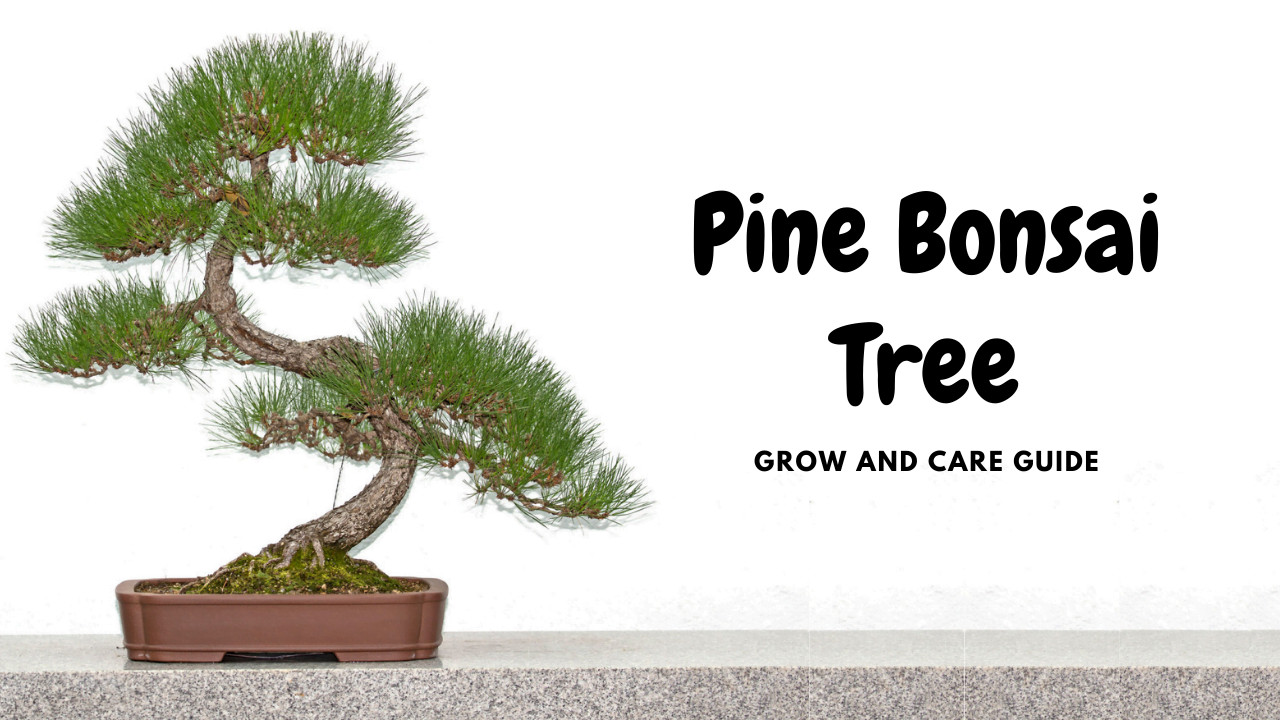It’s no surprise that pine trees are very popular in bonsai cultivation, and many people even consider them the most common kind of bonsai.
Unlike most bonsai trees, pine bonsai trees are evergreen, resinous, or cone-bearing conifers with needle and cone bundles of 2-5.
In nature, pines grow in various shapes and can be shaped in any style famous for bonsai. Traditionally, pine bonsai trees have been Japan’s most popular type of bonsai, surviving for generations.
And in this article, I will discuss this excellent needle-like plant from its growth to its final care. So, keep reading to discover some amazing facts about this bonsai plant.
Indoor bonsai plants are a wonderful way to bring a touch of nature into your home or office. These miniature trees offer many benefits, such as improving air quality and reducing stress. With proper care and attention, indoor bonsai plants can thrive for years, adding beauty and serenity to your space. There are many species of indoor bonsai plants available, so do some research to find the one that suits your needs best.
Varieties of Pine Tree Bonsai
You would be surprised to know that this Pine tree has over 120 varieties. Moreover, most of them are grown as bonsai trees, giving you a lot of choices. However, certain pine species have gained popularity, and these famous ones are listed below.
Pinus Thunbergii

This is also known as the Japanese Black Pine. It is widely regarded as the quintessential bonsai variety. In addition, this is commonly cultivated in Japan. As a homage to the origin of this ancient art, many bonsai enthusiasts often grow at least one of these beauties.
Pinus Thunbergii is prized for the thick, pitted bark that develops with age. However, it is a slow-growing species with long needles and is notoriously difficult to work with.
Pinus Mugo
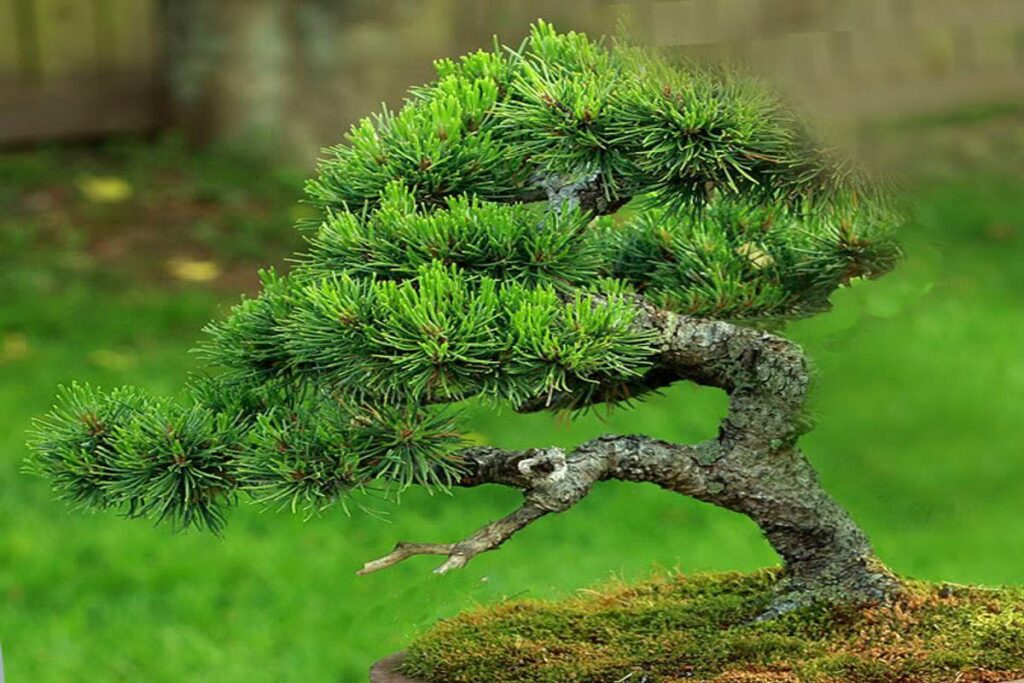
It is known as the Mountain Pine. This variety is prized as a bonsai tree because it is one of the hardiest species. It will tolerate freezing temperatures and scorching summers with little effect on the plant.
On the bedrock near their timberline, it forms depressed shrubs. Moreover, its needles are strong, short, paired, and dark green with dark brown bark.
If you take proper care of Pinus Mugo, it will produce dense, busy growth that you can prune and shape in different bonsai styles. Additionally, this hardy species is beautifully coloured. The young plant starts its life with a purplish hue. And when the plant bloom, it produces beautifully delicate purple flowers.
Pinus Sylvestris
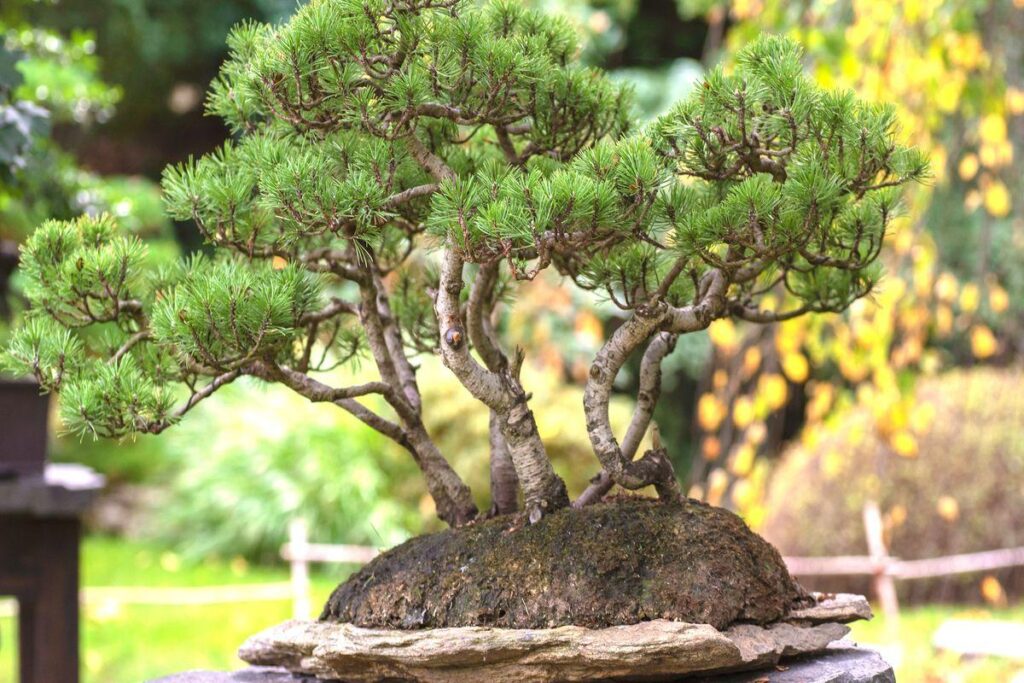
This Pinus variety is popularly known as the Scots Pine. The Scot pine is an excellent pine bonsai species because it naturally takes on the shape that cultivators work hard to create in other trees. As the bonsai plant ages, it drops its lower branches. This gives the tree a beautiful canopied look with little effort on the cultivator’s part.
In appearance, Pinus Sylvestris has clusters of three long needles. Its bark is yellow to orange, and some Scots Pine has pinkish plates with noticeable black crevices.
Pinus Parviflora

This is also called the Japanese White Pine. Pinus Parviflora is famous for its white needles, which are unique among pine species.
It has a feminine design and is mainly found in high mountainous regions. For optimal growth, Japanese White Pine is often grafted on the root systems of Japanese Black Pine. The dwarf cultivars of the Japanese White Pine are Kokonoe, Myojo, and Zuisho.
How to Grow Pine Bonsai Tree
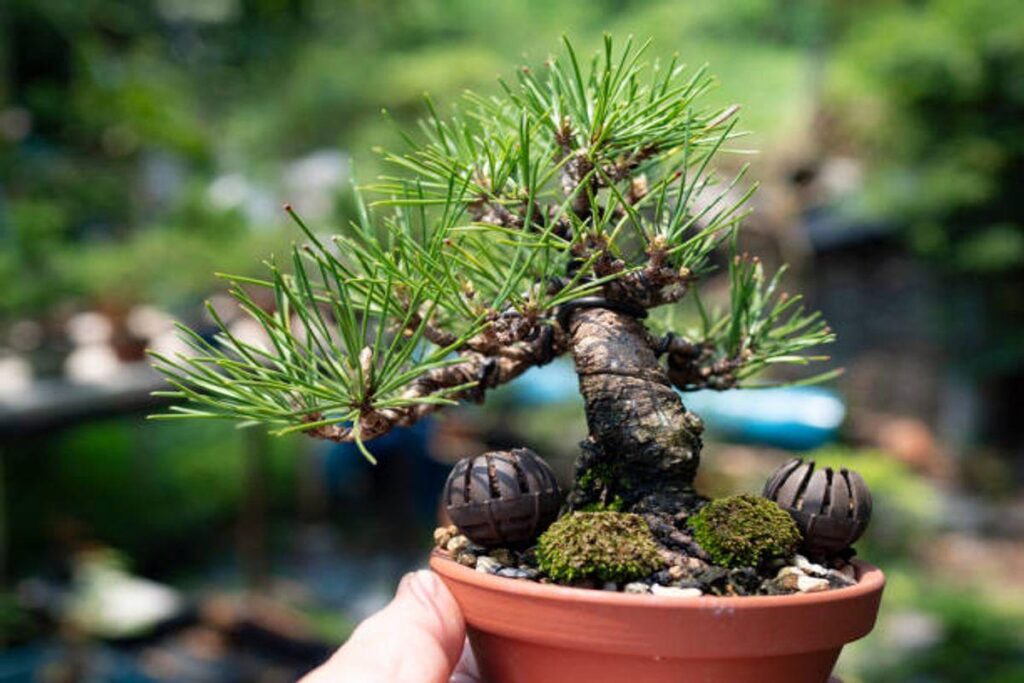
- You can grow a pine tree using seeds in pine cone scales harvested from female cones. Female pine cones are more prominent than their male counterparts. And mature pine cones are woody and brown in appearance.
- One cone can produce about two seeds beneath each scale. These pine seeds will remain in the cone until it dries out and opens up completely.
- You can quickly identify pine seeds by the prominent-looking wing attached to the seed for aid in dispersal. Collect the seed once they fall from the tree in autumn, usually between September and November.
- Lightly shake the collected seeds upside down. It may take numerous seeds before you find any that are fit for planting.
- It is essential to have excellent and healthy seeds to succeed when germinating. So, to test the viability of your pine seeds, put them in a container filled with water and separate those that sink from those that float. The floating seeds are generally the ones that are least likely to germinate.
- Once you get viable seeds, dry them and store them in an airtight container immediately.
- Start the seeds indoors and place them in individual pots with well-drained potting soil.
- Gently push each seed just beneath the soil surface, ensuring it is in a vertical position with the pointy end facing downward.
- Now, place the pot in a sunny window and deeply water it.
- Keep the seed moist and wait, as germination can take a month. Once the seedlings have reached 6-12 inches tall, you can transplant them into a pot.
Pine Bonsai Tree Care
Placement
A pine bonsai tree is happiest when you place it under full, direct sunlight. If your pine is not getting enough sun, it will grow long, spindly needles, drop branches, and thin out.
So, to keep your pine bonsai thick and healthy, look for the sunniest spot on a window sill, shelf, or patio. Set the pine bonsai tree securely in a place and let it live out the warm months.
Light

The pine bonsai tree requires full sun for several hours each day for optimal growth. The more sunlight the pine tree receives, the shorter and more compact the needles will be. If your pine tree indicates leggy and elongated needles, they need more sunlight.
Soil
Like most bonsai species, pine bonsai require well-draining potting mediums. Moreover, commercially available bonsai soil is usually the best. These contain a mix of Akadama (clay granulate mined in Japan), pumice, organic potting compost, and fine gravel. In addition, pine bonsai tree-like soil has a pH between 5.5 and 6.5.
Water
Watering a pine bonsai tree is an art. And to master this art, start to gauge your pine bonsai’s water needs and check the soil once or twice daily.
If you feel your soil is barely moist, on the verge of drying out entirely, give your pine a long drink. However, do not water when your pine bonsai does not need it. Because pine bonsai does not like wet feet, it may develop root rot. Moreover, they dislike dry soil. Due to skipped watering, your pine tree may take some time to recover from bone dry soil.
Temperature and Humidity
Pine bonsai are not ideal for growing indoors, and they should be grown outside year-round. Although they are hardy and frost tolerant trees, when planted in a pot, they should be placed in a sheltered location to protect them from the worst of the winter weather.
As with most bonsai, the pine bonsai trees like moisture and can benefit from regular misting if the climate is not naturally humid.
Fertilizer
Bonsai pine trees require minimal feeding. Because they are prone to growing long needles, although it looks beautiful on a full-size pine tree, making pruning bonsai pine trees difficult. So, by limiting your pine tree’s food supply, you can restrict the size of its needles.
You can start to feed with a 0-10-10 fertilizer. Apply one feeding in early spring as soon as the seasonal growth starts. And next feeding at the end of spring. After that fertilize your pine bonsai with a 12-10-12 fertilizer once every two weeks until the start of fall.
Pause the fertilization in winter, then start up again in early spring. For best results, follow the fertilizer’s instructions. Remember to give a long drink of water after each fertilizer application.
Winter care
A pine tree is a cold-hardy genus. But when grown in a small pot with limited soil, as bonsai are, their roots have little of the insulation that full trees enjoy in the wild.
When snow settles around and freezes pine tree’s roots, its branches are susceptible to damage from freezing winds. At that time, move your tree to a wind shelter or loosely cover its branches with landscape fabric.
Pruning

Pruning a pine bonsai is difficult. Although pruning a pine bonsai is no different than pruning any other bonsai species, every change to a pine’s environment, foliage, or pot must be done slowly. Moreover, there are lots of “don’ts” that you must follow to prevent harming or stunning the pine tree.
Heavy pruning, such as pruning trunks and large branches, must only be taken on in the fall; at that time, the bonsai stops its growth for the year. When the pine tree enters its dormancy, it can tolerate hard pruning.
The pine tree bleeds sap profusely after they are cut. So, to stop the bleeding, coat pruning cuts are made on the trunk or main branch with a layer of petroleum jelly. This will heal and protect the tree from disease or decay while it recovers during the dormant period. Also, never leave a significant pruning cut exposed.
After pruning, allow stumps to dry for one full year before cutting them off flush with their point of origin.
Remember never to prune more than half of a pine’s top growth in one year. It takes time, but it is best to accomplish the pruning in small stages because your pine may not bounce back from severe trunk cuts.
30-year-old pine tree can handle “one insult” per year. If you transplant one year, you must wait until the following year for heavy pruning, wiring, or any other invasive work. Two of these “insults” per year may be weak, stunt, or damage your tree. Although younger pines can handle more than one insult yearly, they don’t like it.
Bonsai pine is tough to handle. Pruning and shaping should be handled slowly as the tree grows and matures. However, mature bonsai require much less fun. But with patience and expertise, pine bonsai can grow into beautiful stately trees worth the extra care and attention.
Potting and Repotting
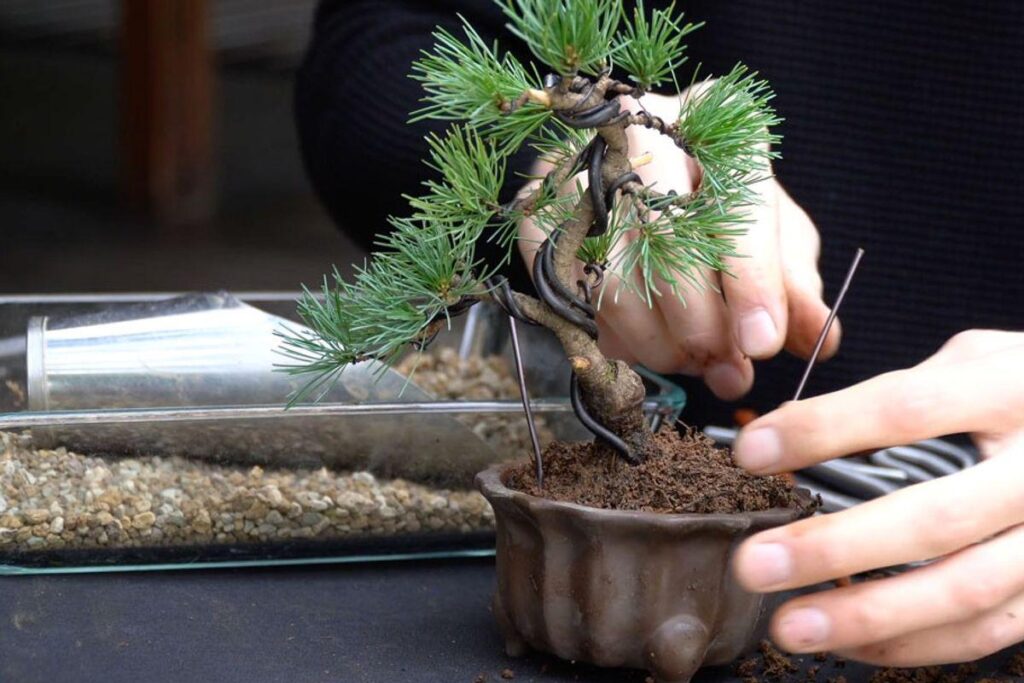
The extended root development indicates the best time to re-pot the bonsai. On average, repotting is required after 2 to 5 years. And it is best carried out in mid-spring just as the new growth begins. The Mugo pine variety responds well when re-potted during the summer months.
While repotting, highly free-draining soil is the best for pine, wherein the roots are not washed, and the old soil is incorporated into the new soil containing Mycorrhiza, a fungus helping to maintain the health of pine bonsai.
Repotting tips
Tip#1: The repotting frequency depends on the bonsai pot size and tree species. The fast-growing tree should be repotted every 2 years or sometimes every year.
Tip#2: Repot older and more mature bonsai trees every 3 to 5 years.
Tip#3: Do not re-pot regularly; first, observe your bonsai tree every early spring to remove the tree from its pot.
Tip#4: A pine bonsai needs repotting when its roots circle the root system. If bonsai roots are contained in soil, wait for another year before you check again.
Tip#5: The ideal time for re-potting is during early spring, when it is still dormant, to reduce the damaging effects of repotting. Repotting during early spring ensures that any damage to the root system while repotting will be healed and repaired soon as the tree starts to grow.
Wiring and Shaping
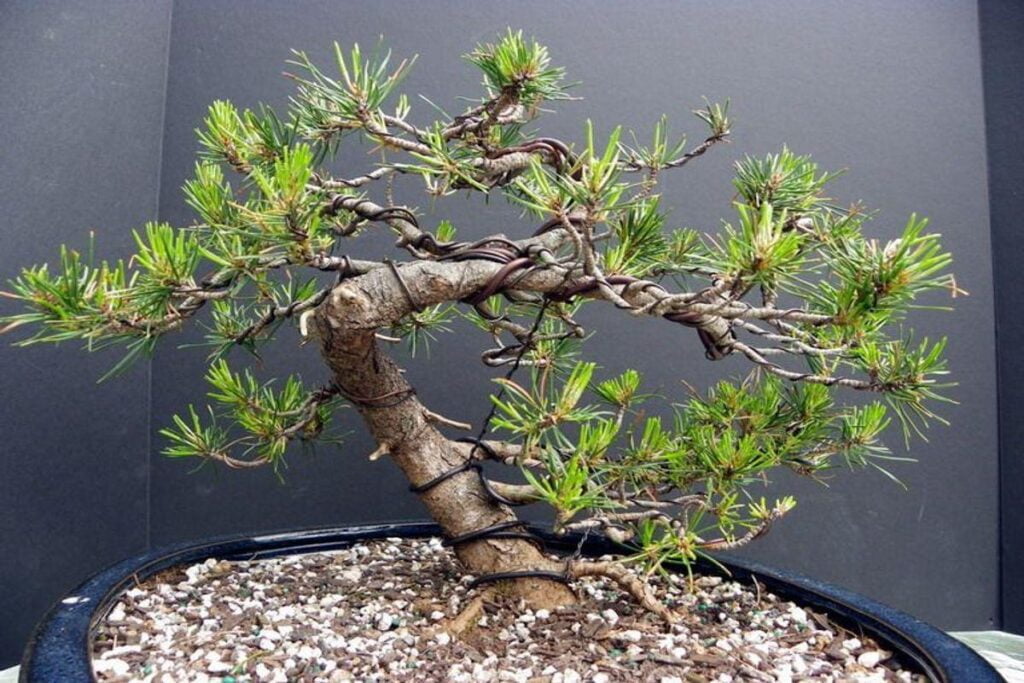
Many bonsai schools instruct the best time to wire a bonsai pine tree. Some say to wire only the latter part of bonsai in autumn or winter. Because the cambium is not active, keep the damage at a minimum.
While other recommends applying wire to bonsai during summer. The best time to wire a bonsai tree is in late autumn and winter. Because the pine branches thicken fast during summer, there is a high risk of damage caused by wiring. In summer, any branch damage can heal by itself.
When you wire branches or trunk of pine bonsai tree, there is a sluggish flow of sap through the trunk or these branches. Through proper wiring and shaping, you can encourage a good branch structure and appropriate formation and growth of foliage pads. Moreover, wiring is a way to distribute energy and vigour to your pine bonsai effectively.
By doing this, the bonsai tree will not feed its energy directly into the tips of its branches. Also, by knowing the best time and how to wire your bonsai trees correctly, you will take good care of them and maintain them for a long time.
Common Pests/Diseases
Unfortunately, the pine bonsai tree is susceptible to several common pests and diseases. So, keep your eye out for aphids, scale, caterpillars, and spider mites, common diseases such as root rot caused due to overwatering or lack of proper drainage, and fungal diseases.
Multiple pesticides should be used in that situation, and it is recommended to seek professional assistance from an expert since pines can die quickly at the first sign of disease. Nevertheless, if pine trees are cared for properly and planted in a sunny location, they will likely live long.
Propagating pine bonsai from cuttings:
Pine bonsai can be propagated by cuttings, but some pine species like Japanese pine bonsai are hard to propagate from cuttings, for that species seed cultivation has a higher success rate. But the positive factor is that the status of the mother tree, especially the age factor, mainly accomplishes by cutting propagation.
Pine bonsai lose their rooting capability from cuttings after five to six years of germination. Certainly, some may yet take root if you use plant hormones or give an ideal rooting environment. But the success rate is so low that I don’t think it’s worth attempting when the age of the mother tree is above 5 years old.
Generally, more roots are formed in the cuttings from the bottom part of the tree than those taken from the center or top of the tree. This is because more stamina and root-promoting substances are kept in higher concentrations at the bottom parts of the trees.
Temperature is regarded as one of the most significant environmental elements in the success of cutting propagation. Pine trees thrive nicely at temperatures between 18°C – 25°C and using an electric heating method to warm the growing media to this range is confirmed to have a much higher success rate.
To grow pine bonsai you will need sterile, sharp pruning shears, rooting medium (small grain Akadama, Kanuma, vermiculite, volcanic stone), pot, rooting hormone (optional), and transparent plastic wrap (optional).
- The first step is to assemble materials. The best time to do this is before spring approaches, from February to March. Choose healthy, strong nodes with new winter growth from the bottom part of the tree.
- Take the pruning shears and prune the bottom of the cutting just below a set of needles. The cuttings should be 6cm long. Put them in water to avoid dehydration. I will also advise you to cut it at a 45-degree angle (it will be easy to insert in the soil).
- You can take out needles at the base of the cuttings, leaving needles at the top.
- Dip the bottom of the cutting into the rooting hormone, following the instructions on the packet. You can skip this part but it helps to improve the rate of rooting.
- Before putting the cuttings in the soil, water the rooting medium properly. Then create some holes in it with the help of a pencil.
- Plant the cutting directly up deep into the rooting medium.
- Cover the pot with a transparent plastic bag or wrap to hold the moisture in and frost out. Humidity also plays a role in the success of rooting.
- Place the cuttings in a spot with natural yet filtered sunlight all day long. Unwrap the plastic bag from time to time to water the soil and mist the cuttings at least once a day. Cuttings cannot soak water before they bear root and misting will stop them from dehydration. Make sure they are moist but not saturated.
- You can place them in a greenhouse if you have one. Warming growing media with an electric heating system can be used to improve the rooting rate.
- Roots should start to form in one to three months and the cutting will produce a good root system in about four to six months. They can be transplanted into their individual pots after a year or so.
FAQs
Can I turn any pine into a bonsai tree?
Pines can be shaped into nearly every bonsai style since they come in various shapes, sizes, and colours. For bonsai cultivation, there is a variety of pine species available.
Can I keep pine bonsai indoors?
In winter, install a bonsai lighting system in your home for your indoor pine bonsai. As your pine is placed inside a pot, it must be protected during the winter. Place your pine bonsai next to a large window sill to ensure sufficient sunlight.
How long does a pine bonsai tree take to grow?
The average pine bonsai tree will take 10 to 15 years to reach maturity, but some can take as many as 30 years.
How often do I need to water a bonsai pine tree?
Pine bonsai generally need to be watered every couple of days, but there is no set schedule. An old bonsai watering trick is to put the entire bonsai pot in a sink of water an inch or two deep; when the topsoil feels dry, water thoroughly.
Conclusion
I hope that you have learned a lot from this article. Although the pine bonsai tree is not ideal for beginners, you can take some steps to increase your knowledge and soon gain and enhance your skills in growing pine bonsai trees. If you need help in this, contact us on Abana Homes, we will be happy to serve you!
Feel free to share your insights and experiences about growing a pine bonsai tree in the comment below.
Related Articles
- Propagating Chinese Elm Bonsai Cuttings And From Seeds
- Best Chinese Elm Bonsai Soil and Fertilizer.
- Troubleshooting Common Problems With Chinese Elm Bonsai
- Buy Chinese Elm Bonsai: How Not to Get Scammed When Purchasing a Chinese Elm Bonsai Tree!
- Chinese Elm Bonsai Pruning And Styling.
- Creating a Chinese Elm Bonsai Forest- Step-By-Step Guide.

